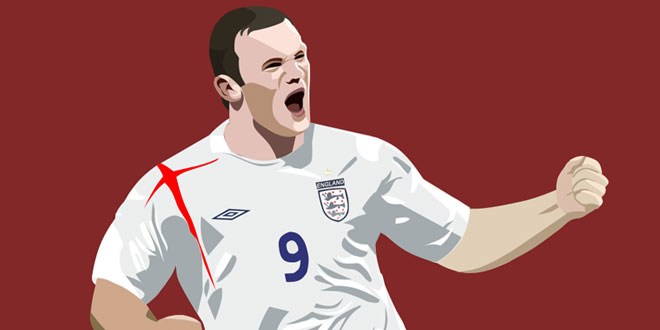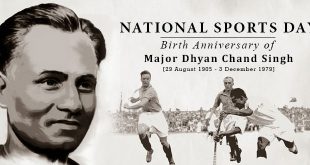Date of birth: 24 October 1985, Croxteth, Liverpool, United Kingdom
Height: 1.76 m
Playing position: Forward
Current teams: Everton, England national football team (#9 / Forward)
Spouse: Coleen Rooney (m. 2008)
Children: Kai Wayne, Klay Anthony, Kit Joseph
Wayne Rooney is one of the world’s best-known soccer players and a top scorer for the Manchester United club.
Wayne Rooney — Wayne Mark Rooney is an English footballer. He currently plays for the English Premier League club Manchester United and the England national team. He normally played as a second striker to Ruud van Nistelrooy for his club team before Van Nistelrooy’s move to Real Madrid, although during 2005-06, he showed his versatility as a player by shifting to the midfield and playing on both flanks. He wears number 8 for Manchester United and wears number 9 the English national team.
Rooney was brought up in an urban area of eastern Liverpool called Croxteth, where he and his two brothers attended the local De La Salle Catholic School.
Wayne Rooney – Best Goals Ever
His boyhood team was always Everton; his love for his home town club was famously bore out when he wore a T-shirt reading “Once a blue, Always a blue”. However, he would end up playing just two seasons with Everton before demanding, and then executing, a transfer. This has left him on unfavourable terms with Everton fans, as they showed when he returned to Goodison Park and he was booed severely.
Although he has been under an intense media spotlight since first arriving on the scene in 2002, it was not until his performances at Euro 2004 that he gained a reputation on the world stage, as he spearheaded the English attack, scoring four goals. Rooney is also on the cover of the FIFA 07 video game in the United Kingdom.
Rooney has also been compared to George Best and Paul Gascoigne in terms of talent.
After excelling for Liverpool Schoolboys and The Dynamo Brownwings, Rooney was signed by Everton shortly before his 11th birthday. Rooney gained national prominence on the 19th of October 2002 when he became the youngest goal scorer in the history of the Premier League at 16 years and 360 days while playing for Everton (though this record has since been surpassed twice). His goal against then-champions Arsenal was a last-minute winner and brought to an end the London side’s 30-match unbeaten run. At the end of 2002 he won the BBC Sports Young Personality of the Year award. On 26 December 2002 he “achieved” the record of becoming the youngest player ever to be sent off in a Premiership game. This is also his only standing record in the Everton books.
He has also figured prominently in recent England international matches, after having become the youngest ever player to play for England, in a friendly against Australia, on 12 February 2003, aged 17 years, 111 days. This record has since been surpassed by Theo Walcott, who came off the bench to play in England’s friendly against Hungary on 30 May 2006. England’s youngest ever player previous to Rooney was James F. M. Prinsep of Clapham Rovers, who made his debut almost one and a quarter centuries before, on 5 April 1879, aged 17 years, 253 days. Rooney is also the youngest England scorer ever (17 years, 317 days).
His reputation as one of the world’s most exciting young players was further enhanced by his impressive performances for England at Euro 2004 in Portugal. At the tournament Rooney became the youngest player ever to score in the UEFA European Football Championships, when on 17 June 2004 he scored twice against Switzerland; although the Swiss player, Johan Vonlanthen, broke this record against France four days later. Unfortunately Rooney was injured early in the quarter final match against Portugal and England were subsequently knocked out on penalties.
There was concern for Rooney’s fitness ahead of the 2006 FIFA World Cup after the fourth metatarsal on his right foot was broken, possibly in several places, following a seemingly innocuous challenge from Paulo Ferreira during Manchester United’s 3-0 defeat away at Chelsea on 29 April 2006, putting him out of action for an estimated six weeks. This was also the first match he played in the re-branded Nike Total 90 ‘supremacy’. The boot’s safety went under the spotlight after many considered it unsafe to wear.
A bone scan on 25 May 2006 suggested he would not be expected to return in time for the World Cup group ties, with a decision to be made on his return to training after these games had passed. Shortly afterwards his international manager confirmed he would travel with the squad to Germany, and would return to have another bone scan on 7 June. Ahead of this scan, Wayne claimed to be feeling fine and was “300% confident” of his own fitness. Rooney was reported to be back, doing light training on 2 June, working on kicking the ball and running.
On 7 June, Wayne Rooney had his second scan, with reports saying he would play in the World Cup as he boarded a flight to Baden-Baden to regroup with the England squad.
On 8 June, Sven-Göran Eriksson said that he was “injury free” and that “he just needs to get back his fitness before he can play”. Eriksson hinted at a possible involvement in the later group stage matches and almost certainly, should England progress, in the second round of the competition.
On 15 June, Sven-Göran Eriksson and FA doctors declared Rooney match fit in time for the match against Trinidad & Tobago. Prior to the match there was much speculation as to whether his health would be risked by playing him at this stage; the speculation was ended when he entered the match in the 58th minute, replacing Michael Owen. Although Rooney did not score, England’s fans were keen to see him running with pace (as if he was match fit many weeks before his medical clearance) and making his presence felt on the attack. On 18 June, Eriksson announced that Rooney would be starting England’s next game. Rooney’s rush into play was much to the dismay of his club team, Manchester United, who were concerned that a full recovery would be jeopardised.
On 20 June, Rooney started in the final group match, England against Sweden, helping England to a 2-2 draw.
On 25 June, Rooney once again started in England’s second round game (knock-out rounds) against Ecuador. Although he failed to score, he looked lively and appeared to be fully fit and definitely match fit.
On 1 July, Rooney was sent off in the quarter final against Portugal while fighting for possession with Chelsea and Portugal defender Ricardo Carvalho. Rooney appeared to stamp down on Carvalho’s groin and was sent off by referee, Horacio Elizondo. Rooney later announced, through the serialisation of his biography in the Daily Mail, that the stamp on Ricardo Carvalho was unintentional. He became only the third English player to be sent off in a World Cup Finals. Due to his red card, he missed England’s opening Euro 2008 qualifiers against Andorra on 2 September and Macedonia on 6 September.
2009–10 Season
On 22 August 2009, he became the 20th Manchester United player to have scored over 100 goals for the club, finding the net twice in a 5-0 away win at Wigan Athletic.
His performance for Manchester United have led many to say he is one of the greatest football players in the world. If not the best player, then in the top two with Lionel Messi of Barcelona.
 Kids Portal For Parents India Kids Network
Kids Portal For Parents India Kids Network







